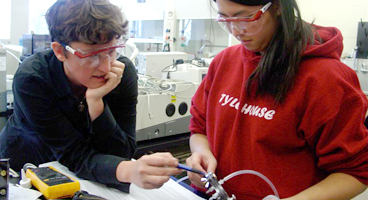Document Type
Article
Publication Date
12-2005
Publication Title
Ear and Hearing
Abstract
Objective:
To determine how the ear canal sound pressure levels generated by circumaural, supra-aural, and insert earphones differ when coupled to the normal adult and infant ear.
Design:
The ratio between the sound pressure generated in an adult ear and an infant ear was calculated for three types of earphones: a circumaural earphone (Natus Medical, ALGO with Flexicoupler™), a supra-aural earphone (Telephonics, TDH-49 with MXAR cushion), and an insert earphone placed in the ear canal (Etymo↕tic Research, ER-3A). The calculations are based on (1) previously published measurements of ear canal impedances in adult and infant (ages 1, 3, 6, 12, and 24 months) ears (Keefe et al., 1993, Acoustic Society of America, 94:2617–2638), (2) measurements of the Thévenin equivalent for each earphone configuration, and (3) acoustic models of the ear canal and external ear.
Results:
Sound-pressure levels depend on the ear canal location at which they are measured. For pressures at the earphone: (1) Circumaural and supra-aural earphones produce changes between infant and adult ears that are less than 3 dB at all frequencies, and (2) insert earphones produce infant pressures that are up to 15 dB greater than adult pressures. For pressures at the tympanic membrane: (1) Circumaural and supra-aural earphones produce infant pressures that are within 2 dB of adult ears at frequencies below 2000 Hz and that are 5 to 7 dB smaller in infant ears than adult ears above 2000 Hz, and (2) insert earphones produce pressures that are 5 to 8 dB larger in infant ears than adult ears across all audiometric frequencies.
Conclusions:
Sound pressures generated by all earphone types (circumaural, supra-aural, and insert) depend on the dimensions of the ear canal and on the impedance of the ear at the tympanic membrane (e.g., infant versus adult). Specific conclusions depend on the location along the ear canal at which the changes between adult and infant ears are referenced (i.e., the earphone output location or the tympanic membrane). With circumaural and supra-aural earphones, the relatively large volume of air within the cuff of the earphone dominates the acoustic load that these earphones must drive, and differences in sound pressure generated in infant and adult ears are generally smaller than those with the insert earphone in which the changes in ear canal dimensions and impedance at the tympanic membrane have a bigger effect on the load the earphone must drive.
Volume
26
Issue
6
First Page
636
Last Page
650
DOI
10.1097/01.aud.0000189717.83661.57
Version
Author's Accepted Manuscript
Recommended Citation
Voss, Susan E. and Herrmann, Barbara S., "How Does the Sound Pressure Generated by Circumaural, Supra-aural, and Insert Earphones Differ for Adult and Infant Ears?" (2005). Engineering: Faculty Publications, Smith College, Northampton, MA.
https://scholarworks.smith.edu/egr_facpubs/145


